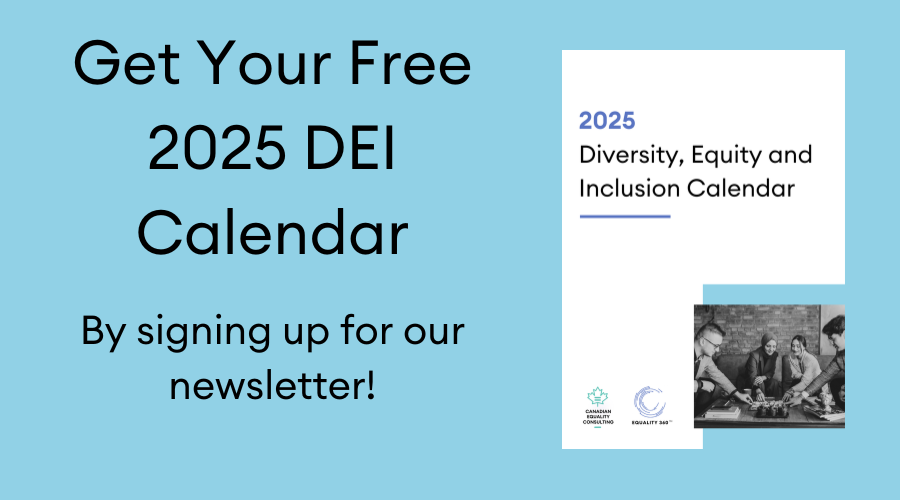
How do you monitor diversity in the workplace?
Diversity and inclusion in the workplace are no longer optional, they are legal requirements. The Canadian Human Rights Act prohibits discrimination based on gender, race, ethnicity, and many other diversity and identity grounds. Also, Canada’s Employment Equity Act and the Federal Contractors Program require employers to take active measures to improve their employment opportunities for certain groups of people. Monitoring diversity is crucial to help find and highlight inequalities and to gain valuable insight into any underlying causes of discrimination and bias. So how does one monitor diversity, equity, and inclusion in the workplace?
1. Data collection
To ascertain how well your organization is doing with regard to equality and diversity in the workplace, a data collection strategy is recommended. Remember to collect and store data in line with the Data Protection Act. Assure staff that any forms they fill in will be used solely for ensuring a fair and equal workplace for all and that it will be kept separate from other documents. When you start gathering the information you should start at the very beginning from before you even begin to interview candidates–and that is where and how you advertise for staff. Collect detailed disaggregated data through forms or questionnaires that have specific categories like gender, age, race, ethnicity, ability, sexual orientation, and so forth to help you get this information, ensuring that options for identity questions are diverse. For example, provide “another” or “prefer not to respond” after an inclusive list of options. This disaggregated data will give you a better idea of how diverse your current workforce is, and alert you to any areas that need improvement. Furthermore, It will give you a better idea of your brand’s reputation and how good (or bad) your organization is at attracting and retaining candidates from certain groups of people and/or nationalities, races, ages, or sexual orientations. The data will also illuminate where in your recruitment and hiring processes you have weak points or gaps. It will reveal whether you’re not advertising positions in the right locations to attract diversity or whether you may have biases in your interview process if that is where many diverse candidates are screened out of the competition.
2. Reviewing collected data
Once you have collected all your data – it will need to be reviewed. Regularly collecting and analyzing this data is imperative to see where you stand on an ongoing basis concerning diversity and inclusion. Assess which departments within your organization could improve by having a better mix of people or more flexible working environments. Remember that diversity is not limited to race, gender, age, religion, and/or sexual orientation. It also applies to having non-standard working contracts, like for example: allowing working parents an opportunity to work part-time. Or, allowing other employees the opportunity to work from home on certain days of the week. It’s all about being in tune with your employees and their needs so that you can build loyalty and trust and thus improve productivity.
3. Taking action
If you can see from your data collection and analysis that you are still falling short, it will now be easy to see where you need to improve. For example: perhaps you are not hiring employees from certain groups of people. This could be addressed by changing the way you recruit staff. Perhaps your organization has always used the same recruitment agency. Or perhaps if you have never advertised vacancies on social media or through specific organizations that serve diverse populations before, now is the time to try that method of recruiting staff. Rewriting job ads or changing the imagery of ads may make them more appealing to different groups of people. By broadening your reach you could tap into a broad spectrum of people that may not initially have thought to apply for the job.
Monitoring diversity, equity, and inclusion in your workplace is an ongoing process. It is important to understand your personal biases and assumptions throughout the monitoring process. At Canadian Equality Consulting, we provide diversity, equity, and inclusion workplace assessments using an intersectional lens. Our process goes beyond standard methodologies for assessing and monitoring diversity, equity, and inclusion in the workplace and includes research, surveys, policy and program reviews, focus groups and interviews, benchmarking, and comparative analysis, among others. The data collected is used to inform and build strategic and actionable plans with built-in evaluation and accountability mechanisms.
Benefits of diversity monitoring
Diversity monitoring helps you to reach evidence-based decisions on where you need to improve. It helps you to recruit from a wider talent pool and thus get better candidates. Furthermore, more people will want to work for a company that is flexible to their needs and that respects their values and their background. When you can assess where and when unfair practices are taking place, then you can address them effectively and promptly. This will optimize staff retention and save your organization on the costs of hiring and training new employees.

